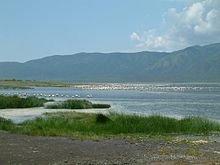Bogoria lake
| Bogoria lake | ||
|---|---|---|

|
||
| Satellite image of Lake Bogoria | ||
| Geographical location | East Africa , Kenya | |
| Tributaries | Waseges (Sandai), Emsos, thermal springs | |
| Drain | none | |
| Data | ||
| Coordinates | 0 ° 16 ′ N , 36 ° 6 ′ E | |
|
|
||
| Altitude above sea level | 970 m | |
| surface | 33 km² | |
| length | 17.7 km | |
| width | 3.6 km | |
| volume | 0.18 km³ | |
| Maximum depth | 9 m | |
| Middle deep | 5 m | |
| Catchment area | 700 km² | |
|
particularities |
||
The Lake Bogoria ( Lake Bogoria , formerly Lake Hannington ) is a highly alkaline Lake Natron in the eastern arm of the East African Rift . The lake has a length of 17.3 km and a maximum width of 3.8 km. The water temperature is up to 70 ° C in places. The lake is known for its abundance of birds, its numerous geysers and thermal springs . These are mainly located on the west bank. The lake is meromictic .
The lake belongs since 2011 as part of the " Kenyan lakes system in the Great Rift Valley " for UNESCO - World Heritage .
geography
The lake is located in the eastern part of the East African Rift Valley ( Great Rift Valley ). He is, together with the more northern Lake Baringo in Baringo Bogoria Basin. The Lake Bogoria is located in a half-trench , of the east by a removal and the associated morphological fracture stage ( Siracho Escarpment is limited). The catchment area of the lake has a size of 700 square kilometers.
The lake is located in Baringo County in Kenya , 181 km north-northwest of the capital Nairobi . It is located in the Bogoria National Reserve .
Flora and fauna
The Bogoria Lake is the destination of numerous excursionists, not least because of the diverse flora and fauna. The fauna at the lake includes zebras , gazelles , impalas , dikdiks and kudu . The lake is home to numerous flamingos , fish eagles and pelicans . The main food source of the flamingos are the cyanobacteria Spirulina platensis .
In autumn 1999, around 30,000 flamingos fell victim to anatoxin A in Lake Bogoria . The toxin was found in the stomach contents of dead animals and in their excrement. To this day, the anatoxin A-producing cyanobacteria that occur there ensure an annual mass extinction among the flamingos, which feed on non-toxic cyanobacteria, mostly spirulina . The causative organisms occur naturally in the water of the lake and to a small extent in particular in microbe mats that grow around the thermal springs in the lake bed.
Web links
Individual evidence
- ↑ Entry on the website of the UNESCO World Heritage Center ( English and French ).
- ↑ L. Krienitz, A. Ballot, K. Kotut, C. Wiegand, S. Pütz, JS Metcalf, GA Codd, S. Pflugmacher: Contribution of hot spring cyanobacteria to the mysterious deaths of Lesser Flamingos at Lake Bogoria, Kenya. In: FEMS microbiology ecology. Volume 43, Number 2, March 2003, pp. 141-148, doi : 10.1111 / j.1574-6941.2003.tb01053.x , PMID 19719674 .


